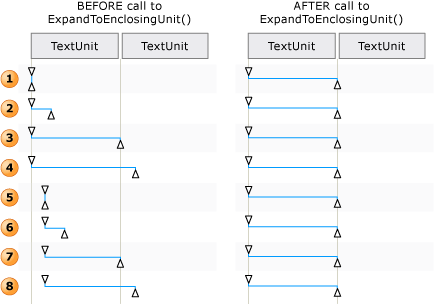TextPatternRange.MoveEndpointByUnit Method
Definition
Important
Some information relates to prerelease product that may be substantially modified before it’s released. Microsoft makes no warranties, express or implied, with respect to the information provided here.
Moves one endpoint of the text range the specified number of TextUnits within the document range.
public:
int MoveEndpointByUnit(System::Windows::Automation::Text::TextPatternRangeEndpoint endpoint, System::Windows::Automation::Text::TextUnit unit, int count);public int MoveEndpointByUnit (System.Windows.Automation.Text.TextPatternRangeEndpoint endpoint, System.Windows.Automation.Text.TextUnit unit, int count);member this.MoveEndpointByUnit : System.Windows.Automation.Text.TextPatternRangeEndpoint * System.Windows.Automation.Text.TextUnit * int -> intPublic Function MoveEndpointByUnit (endpoint As TextPatternRangeEndpoint, unit As TextUnit, count As Integer) As IntegerParameters
- endpoint
- TextPatternRangeEndpoint
The endpoint to move.
- unit
- TextUnit
The textual unit for moving.
- count
- Int32
The number of units to move. A positive count moves the endpoint forward. A negative count moves backward. A count of 0 has no effect.
Returns
The number of units actually moved, which can be less than the number requested if moving the endpoint runs into the beginning or end of the document.
Examples
private Int32 MoveEndpointByRangeFromSelection(AutomationElement target, Int32 units)
{
// Specify the control type we're looking for, in this case 'Document'
PropertyCondition cond = new PropertyCondition(AutomationElement.ControlTypeProperty, ControlType.Document);
// target --> The root AutomationElement.
AutomationElement textProvider = target.FindFirst(TreeScope.Descendants, cond);
TextPattern textpatternPattern = textProvider.GetCurrentPattern(TextPattern.Pattern) as TextPattern;
if (textpatternPattern == null)
{
Console.WriteLine("Root element does not contain a descendant that supports TextPattern.");
return 0;
}
TextPatternRange[] currentSelection = textpatternPattern.GetSelection();
return currentSelection[0].MoveEndpointByUnit(
TextPatternRangeEndpoint.Start, TextUnit.Paragraph, units);
}
Private Function MoveEndpointByRangeFromSelection(ByVal target As AutomationElement, ByVal units As Int32) As Int32
' Specify the control type we're looking for, in this case 'Document'
Dim cond As PropertyCondition = New PropertyCondition(AutomationElement.ControlTypeProperty, ControlType.Document)
' target --> The root AutomationElement.
Dim textProvider As AutomationElement = target.FindFirst(TreeScope.Descendants, cond)
Dim textpatternPattern As TextPattern = CType(textProvider.GetCurrentPattern(TextPattern.Pattern), TextPattern)
If (textpatternPattern Is Nothing) Then
Console.WriteLine("Root element does not contain a descendant that supports TextPattern.")
Return Nothing
End If
Dim currentSelection As TextPatternRange() = textpatternPattern.GetSelection()
' GetText(-1) retrieves all characters but can be inefficient
Return currentSelection(0).MoveEndpointByUnit(TextPatternRangeEndpoint.Start, TextUnit.Paragraph, units)
End Function
Remarks
When it is necessary to traverse the content of a text range, a series of steps are involved behind the scenes in order for the Move method to execute successfully.
The text range is normalized; that is, the text range is collapsed to a degenerate range at the Start endpoint, which makes the End endpoint superfluous. This step is necessary to remove ambiguity in situations where a text range spans
unitboundaries; for example, "{The U}RL https://www.microsoft.com/ is embedded in text" where "{" and "}" are the text range endpoints.The resulting range is moved backward in the DocumentRange to the beginning of the requested
unitboundary.The range is then expanded from a degenerate range state by moving the End endpoint by one requested
unitboundary.

Examples of how a text range is adjusted for Move() and ExpandToEnclosingUnit()
The textual content (or inner text) of a text container and an embedded object, such as a hyperlink or table cell, is exposed as a single, continuous text stream in both the control view and the content view of the UI Automation tree; object boundaries are ignored. If a UI Automation client is retrieving the text for the purpose of reciting, interpreting, or analyzing in some manner, the text range should be checked for special cases, such as a table with textual content or other embedded objects. This can be accomplished by calling GetChildren to obtain an AutomationElement for each embedded object and then calling RangeFromChild to obtain a text range for each element; this is done recursively until all textual content has been retrieved.

Example of a text stream with embedded objects and their range spans
MoveEndpointByUnit defers to the next largest TextUnit supported if the given TextUnit is not supported by the control.
The order, from smallest unit to largest, is listed below.
